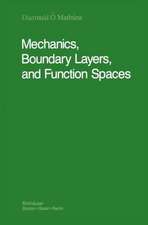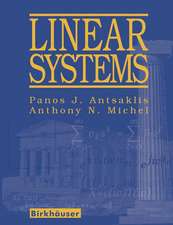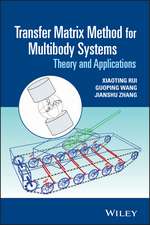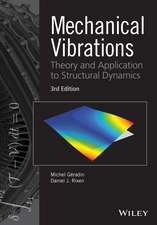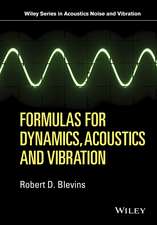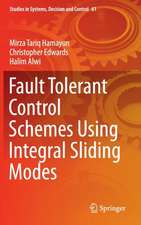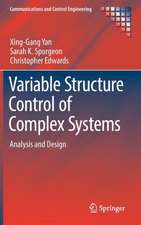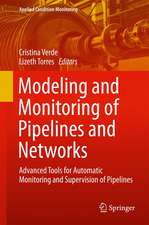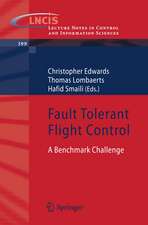Sliding Mode Control and Observation: Control Engineering
Autor Yuri Shtessel, Christopher Edwards, Leonid Fridman, Arie Levanten Limba Engleză Paperback – 24 iul 2015
The present volume addresses a range of sliding mode control issues, including:
*Conventional sliding mode controller and observer design
*Second-order sliding mode controllers and differentiators
*Frequency domain analysis of conventional and second-order sliding mode controllers
*Higher-order sliding mode controllers and differentiators
*Higher-order sliding mode observers
*Sliding mode disturbance observer based control
*Numerous applications, including reusable launch vehicle and satellite formation control, blood glucose regulation, and car steering control are used as case studies
Sliding Mode Control and Observation is aimed at graduate students with a basic knowledge of classical control theory and some knowledge of state-space methods and nonlinear systems, while being of interest to a wider audience of graduate students in electrical/mechanical/aerospace engineering and applied mathematics, as well as researchers in electrical, computer, chemical, civil, mechanical, aeronautical, and industrial engineering, applied mathematicians, control engineers, and physicists. Sliding Mode Control and Observation provides the necessary tools for graduate students, researchers and engineers to robustly control complex and uncertain nonlinear dynamical systems. Exercises provided at the end of each chapter make this an ideal text for an advanced course taught in control theory.
| Toate formatele și edițiile | Preț | Express |
|---|---|---|
| Paperback (1) | 465.83 lei 38-44 zile | |
| Springer – 24 iul 2015 | 465.83 lei 38-44 zile | |
| Hardback (1) | 569.55 lei 38-44 zile | |
| Springer – iun 2013 | 569.55 lei 38-44 zile |
Din seria Control Engineering
- 18%
 Preț: 756.05 lei
Preț: 756.05 lei - 18%
 Preț: 808.96 lei
Preț: 808.96 lei - 18%
 Preț: 876.05 lei
Preț: 876.05 lei - 20%
 Preț: 787.14 lei
Preț: 787.14 lei - 18%
 Preț: 962.18 lei
Preț: 962.18 lei - 15%
 Preț: 690.71 lei
Preț: 690.71 lei - 18%
 Preț: 931.86 lei
Preț: 931.86 lei - 18%
 Preț: 717.73 lei
Preț: 717.73 lei - 18%
 Preț: 929.36 lei
Preț: 929.36 lei - 15%
 Preț: 637.33 lei
Preț: 637.33 lei - 15%
 Preț: 641.66 lei
Preț: 641.66 lei - 15%
 Preț: 636.05 lei
Preț: 636.05 lei - 15%
 Preț: 639.91 lei
Preț: 639.91 lei - 20%
 Preț: 581.39 lei
Preț: 581.39 lei - 15%
 Preț: 636.36 lei
Preț: 636.36 lei - 15%
 Preț: 529.70 lei
Preț: 529.70 lei -
 Preț: 374.46 lei
Preț: 374.46 lei - 15%
 Preț: 695.87 lei
Preț: 695.87 lei - 18%
 Preț: 1095.09 lei
Preț: 1095.09 lei - 18%
 Preț: 1655.20 lei
Preț: 1655.20 lei -
 Preț: 393.94 lei
Preț: 393.94 lei - 15%
 Preț: 639.91 lei
Preț: 639.91 lei - 18%
 Preț: 936.65 lei
Preț: 936.65 lei - 15%
 Preț: 692.99 lei
Preț: 692.99 lei - 18%
 Preț: 934.93 lei
Preț: 934.93 lei - 18%
 Preț: 1007.85 lei
Preț: 1007.85 lei - 15%
 Preț: 635.23 lei
Preț: 635.23 lei - 18%
 Preț: 944.58 lei
Preț: 944.58 lei - 15%
 Preț: 570.41 lei
Preț: 570.41 lei - 15%
 Preț: 632.51 lei
Preț: 632.51 lei -
 Preț: 387.51 lei
Preț: 387.51 lei - 20%
 Preț: 643.53 lei
Preț: 643.53 lei - 19%
 Preț: 569.55 lei
Preț: 569.55 lei - 18%
 Preț: 936.33 lei
Preț: 936.33 lei
Preț: 465.83 lei
Nou
Puncte Express: 699
Preț estimativ în valută:
89.15€ • 92.88$ • 74.12£
89.15€ • 92.88$ • 74.12£
Carte tipărită la comandă
Livrare economică 07-13 februarie 25
Preluare comenzi: 021 569.72.76
Specificații
ISBN-13: 9781489991225
ISBN-10: 1489991220
Pagini: 376
Ilustrații: XVII, 356 p. 168 illus.
Dimensiuni: 155 x 235 x 20 mm
Greutate: 0.53 kg
Ediția:Softcover reprint of the original 1st ed. 2014
Editura: Springer
Colecția Birkhäuser
Seria Control Engineering
Locul publicării:New York, NY, United States
ISBN-10: 1489991220
Pagini: 376
Ilustrații: XVII, 356 p. 168 illus.
Dimensiuni: 155 x 235 x 20 mm
Greutate: 0.53 kg
Ediția:Softcover reprint of the original 1st ed. 2014
Editura: Springer
Colecția Birkhäuser
Seria Control Engineering
Locul publicării:New York, NY, United States
Public țintă
GraduateCuprins
Preface.- Introduction: intuitive theory of sliding mode control.- Conventional Sliding Modes.- Conventional Sliding Mode Observers.- Second order sliding mode controllers and differentiators.- Analysis of sliding mode controllers in the frequency domain.- Higher order sliding mode controllers and differentiators.- Observation and Identification via HOSM-Observers.- Disturbance Observer Based Control: Aerospace Applications.- A Mathematical Preliminaries.- B Describing Functions.- C Linear Systems Theory.- D Lyapunov Stability.- Bibliography.
Recenzii
From the book reviews:
“This book covers several different topics related to sliding mode control and observation. … The book succeeds in being reasonably self-contained. A reader, such as a graduate student … will find most of the book very accessible. Also, as a collection of recent results and applications, the book is a valuable reference for researchers and engineers in the field of robust control of complex and uncertain nonlinear dynamical systems.” (Elisabetta Punta, Mathematical Reviews, August, 2014)
“This book covers several different topics related to sliding mode control and observation. … The book succeeds in being reasonably self-contained. A reader, such as a graduate student … will find most of the book very accessible. Also, as a collection of recent results and applications, the book is a valuable reference for researchers and engineers in the field of robust control of complex and uncertain nonlinear dynamical systems.” (Elisabetta Punta, Mathematical Reviews, August, 2014)
Textul de pe ultima copertă
The sliding mode control methodology has proven effective in dealing with complex dynamical systems affected by disturbances, uncertainties and unmodeled dynamics. Robust control technology based on this methodology has been applied to many real-world problems, especially in the areas of aerospace control, electric power systems, electromechanical systems, and robotics. Sliding Mode Control and Observation represents the first textbook that starts with classical sliding mode control techniques and progresses toward newly developed higher-order sliding mode control and observation algorithms and their applications.
The present volume addresses a range of sliding mode control issues, including:
*Conventional sliding mode controller and observer design
*Second-order sliding mode controllers and differentiators
*Frequency domain analysis of conventional and second-order sliding mode controllers
*Higher-order sliding mode controllers and differentiators
*Higher-order sliding mode observers
*Sliding mode disturbance observer based control
*Numerous applications, including reusable launch vehicle and satellite formation control, blood glucose regulation, and car steering control are used as case studies
Sliding Mode Control and Observation is aimed at graduate students with a basic knowledge of classical control theory and some knowledge of state-space methods and nonlinear systems, while being of interest to a wider audience of graduate students in electrical/mechanical/aerospace engineering and applied mathematics, as well as researchers in electrical, computer, chemical, civil, mechanical, aeronautical, and industrial engineering, applied mathematicians, control engineers, and physicists. Sliding Mode Control and Observation provides the necessary tools for graduate students, researchers and engineers to robustly control complex and uncertain nonlinear dynamical systems. Exercises provided at the end of each chapter make this an ideal text for an advanced course taught in control theory.
The present volume addresses a range of sliding mode control issues, including:
*Conventional sliding mode controller and observer design
*Second-order sliding mode controllers and differentiators
*Frequency domain analysis of conventional and second-order sliding mode controllers
*Higher-order sliding mode controllers and differentiators
*Higher-order sliding mode observers
*Sliding mode disturbance observer based control
*Numerous applications, including reusable launch vehicle and satellite formation control, blood glucose regulation, and car steering control are used as case studies
Sliding Mode Control and Observation is aimed at graduate students with a basic knowledge of classical control theory and some knowledge of state-space methods and nonlinear systems, while being of interest to a wider audience of graduate students in electrical/mechanical/aerospace engineering and applied mathematics, as well as researchers in electrical, computer, chemical, civil, mechanical, aeronautical, and industrial engineering, applied mathematicians, control engineers, and physicists. Sliding Mode Control and Observation provides the necessary tools for graduate students, researchers and engineers to robustly control complex and uncertain nonlinear dynamical systems. Exercises provided at the end of each chapter make this an ideal text for an advanced course taught in control theory.
Caracteristici
Provides the reader with a broad range of material from first principles up to the current state-of-the-art in the area of sliding mode control and observation Practical case studies, which present the results of real sliding mode controller implementations, are used to illustrate the successful practical application of the theory Exercises are provided at the end of each chapter Includes supplementary material: sn.pub/extras


